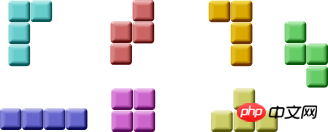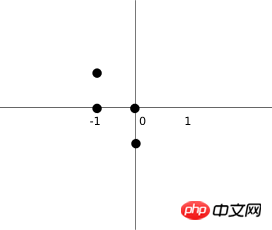Home > Article > Web Front-end > Learn while playing with HTML5 (9) - Data Model of Tetris
1. Start from the data or the interface
To write a Tetris mini-game, let’s first consider the following issues:
1 , What to use to represent the blocks
2. How to set or change the color of the blocks
3. How to move the blocks
4. How to eliminate the blocks
Please consider Look down again after a minute. . . . . .
If you think about the above questions, each answer is related to the interface, control, and platform. That is to say, if you are using .Net, each of your answers will revolve around how to use controls. , how to use the form, which attribute to change in which event of the control, etc., then it means that you have been poisoned by Microsoft's RAD development environment. I suggest that you throw away Visual Studio immediately and switch to other lightweight programming languages. and development platform, so that you can focus more on the problem itself, rather than the control.
Remember: program = data structure + algorithm
The interface is just the appearance of the data, and the data is the essence of the problem.
Below, we will build a data model for a Tetris game step by step. When the entire model is established, we will find that although there is no interface, it still does not prevent this from being a fully functional Tetris game. Because everything that happened was clear, we just didn't draw it. Of course, we will provide an easy-to-operate interface later. In the next article, we will specifically discuss the interface issues.
2. "Shape" data model
Tetris is an enduring mini-game. The most common versions generally include The seven shapes are:
Straight line, S-shaped, Z-shaped, L-shaped, reverse L-shaped, T-shaped, square, etc., as shown below:

So how do we represent these seven shapes in the program? We found that each shape is composed of four small squares, which we can express with four points.
But the question comes again, what are the coordinates of the four points? The method I found is: Each shape has its own coordinate system, such as the S shape, which can be represented by the following figure:

In this way, the S-shaped data model can be expressed as an array of four points: [ [ 0, -1 ], [ 0, 0 ], [ -1, 0 ], [ -1, 1 ] ] .
We can use the same method to build array models of other shapes, and then combine the array models of these seven shapes to form a large array.
Also, each shape can be solid color or have its own color. Adding color will increase the complexity of programming, but not much, so we will also consider color in our model.
Finally, we'd better give each shape a number so that it's easier to apply them in the shape array and color array.
After completing the above analysis, we can give the code of the shape data model:
形状模型的代码
Code highlighting produced by Actipro CodeHighlighter (freeware)
http://www.CodeHighlighter.com/
-->//各种形状的编号,0代表没有形状
NoShape=0;
ZShape=1;
SShape=2;
LineShape=3;
TShape=4;
SquareShape=5;
LShape=6;
MirroredLShape=7
//各种形状的颜色
Colors=["black","fuchsia","#cff","red","orange","aqua","green","yellow"];
//各种形状的数据描述
Shapes=[
[ [ 0, 0 ], [ 0, 0 ], [ 0, 0 ], [ 0, 0 ] ],
[ [ 0, -1 ], [ 0, 0 ], [ -1, 0 ], [ -1, 1 ] ],
[ [ 0, -1 ], [ 0, 0 ], [ 1, 0 ], [ 1, 1 ] ],
[ [ 0, -1 ], [ 0, 0 ], [ 0, 1 ], [ 0, 2 ] ],
[ [ -1, 0 ], [ 0, 0 ], [ 1, 0 ], [ 0, 1 ] ],
[ [ 0, 0 ], [ 1, 0 ], [ 0, 1 ], [ 1, 1 ] ],
[ [ -1, -1 ], [ 0, -1 ], [ 0, 0 ], [ 0, 1 ] ],
[ [ 1, -1 ], [ 0, -1 ], [ 0, 0 ], [ 0, 1 ] ]
];3. Position and rotate the shape
1. Positioning
We mentioned above that each shape is described in its own coordinate system. There is also a global coordinate system used to define the shape. Positioning, so we need a method to convert the four points of the shape from its own coordinate system to the global coordinate system to position the shape.
Suppose the coordinates of the four points of the S-type in its own coordinate system are: [ [ 0, -1 ], [ 0, 0 ], [ -1, 0 ], [ -1, 1 ] ] Its current position in the global coordinate system is: [12,8] Then, the coordinates of the four points converted into the global coordinate system are: [ [ 0+12, -1+8 ] , [ 0+12, 0+8 ], [ -1+12, 0+8 ], [ -1+12, 1+8 ] ]In this way, we have completed the global coordinates of the S-type Convert. One thing to note here is that the coordinate system of the shape itself is described by (x, y), while the global coordinate system is described by (row, col) in order to be more logically intuitive, so we actually In programming, it is not converted as above, but: [ [ -1+12, 0+8 ], [ 0+12, 0+8 ], [ 0+12, -1+8 ], [ 1+12, -1+8 ] ]That is: first change x to col, y to row, and then convert to the global coordinate system.2. Rotation
Rotation is done in the shape’s own coordinate system and around the origin of the shape. The formula is very simple. The relationship between the coordinates of a point after rotation and the coordinates before rotation is as follows (rotate to the right): x' = yy' = -xNote : The square shape does not rotate.
With the above analysis, we can give two global methods, which are used to globally position and rotate shapes:全局定位和旋转的代码
Code highlighting produced by Actipro CodeHighlighter (freeware)
http://www.CodeHighlighter.com/
-->//将形状自身的坐标系转换为 Map 的坐标系,row col 为当前形状原点在 Map 中的位置
function translate(data,row,col){
var copy=[];
for(var i=0;i<4;i++){
var temp={};
temp.row=data[i][1]+row;
temp.col=data[i][0]+col;
copy.push(temp);
}
return copy;
}
//向右旋转一个形状:x'=y, y'=-x
function rotate(data){
var copy=[[],[],[],[]];
for(var i=0;i<4;i++){
copy[i][0]=data[i][1];
copy[i][1]=-data[i][0];
}
return copy;
}
4. Moving space
前面我们说过,形状是由四个点组成的,而形状的移动空间也是由 m * n 个点组成的一个二维数组。
这里为了更直观的描述,我将 n 个点组成一条线 Line,再将 m 条 Line 组成形状的移动空间,我把它叫做 Map 。
我们有了这 m * n 个点有什么用呢?用处很简单,就是保存形状的编号,如果一个点没有被形状占用,则编号为 NoShape。这就是前面给出形状编号的用处,同时也是为什么要有一个 NoShape 编号的原因。
Map 应该具有什么功能呢?下面我列举了一些:
1、构造函数:这不用说了,n 个点组成一行 Line, m 行 Line 组成Map,每个点初始化成 NoShape
2、newLine:生成新的一行。为什么需要这个方法呢,因为除了构造函数中,游戏运行过程中我们也需要用到它,当一行或者几行被消除以后,我们需要在顶部假如一行或者几行新的Line
3、isFullLine(row):这个方法用来判断第 row 行是否满了,每次一个形状落地后,就需要对每一行进行这个判断,满了当然是消除了。
4、isCollide(data): data 是一个定位后的形状数据,这样我们就可以检查这些数据是否超出移动空间的上下左右边界,另外还检查数据的四个点是否已经被占用,这就是碰撞检测。
5、appendShape(shape_id,data):当一个形状落地以后,我们就应该将运行空间中某些点的值改变为这个形状的编号,我把这称为占用。
6、消除操作:这个功能没有单独列为一个方法,我把它放在 appendShape 方法中了。消除操作也很简单,发现某一行 isFullLine 了以后,在 lines 数组中移除这一行,并在 lines 数组的顶部加入一个空行即可。
有了上面的分析,我们就可以给出移动空间的代码了:
移动空间的代码
Code highlighting produced by Actipro CodeHighlighter (freeware)
http://www.CodeHighlighter.com/
-->/*
* 说明:由 m 行 Line 组成的格子阵
*/
function Map(w,h){
//游戏区域的长度和宽度
this.width=w;
this.height=h;
//生成 height 个 line 对象,每个 line 宽度为 width
this.lines=[];
for(var row=0;rowthis.width 超出左右边界
* 2:row==this.height ,说明形状已经到最底部
* 3:任意一点的 shape_id 不为 NoShape ,则发生碰撞
* 如果发生碰撞则放弃移动或者旋转
*/
Map.prototype.isCollide=function(data){
for(var i=0;i<4;i++){
var row=data[i].row;
var col=data[i].col;
if(col<0 || col==this.width) return true;
if(row==this.height) return true;
if(row<0) continue;
else
if(this.lines[row][col]!=NoShape)
return true;
}
return false;
}
//形状在向下移动过程中发生碰撞,则将形状加入到 Map 中
Map.prototype.appendShape=function(shape_id,data){
//对于形状的四个点:
for(var i=0;i<4;i++){
var row=data[i].row;
var col=data[i].col;
//找到所在的格子,将格子的颜色改为形状的颜色
this.lines[row][col]=shape_id;
}
//========================================
//形状被加入到 Map 中后,要进行逐行检测,发现满行则消除
for(var row=0;row五、游戏模型
我们有了游戏的数据模型,我们就可以读写他们了。所谓读好理解,所谓写就是改变他们,改变的方法当然是用户的操作了。
下面给出 GameModel 类,他维护三个主要的数据:
1、一个形状的编号,就是用户可以操作移动的那个形状
2、形状的全局位置,用 row col 表示
3、一个 Map,用它完成碰撞检测,添加等操作
另外,还抽象出几个用户的操作动作:
1、left:左移。将形状的全局坐标 col 减少 1 。请思考一下,这样就可以了吗?当然不行,我们还需要进行碰撞检测,如果已经在最左边,则放弃处理。
2、right:右移。同上。
3、rotate:旋转。同上。
4、down:下落。同上。下落过程中的碰撞检测有所不同,一旦发生碰撞,我们不能再放弃处理了,而是要将当前形状加入到空间中。
5、GameOver:下落过程中还需要进行一个检测就是游戏是否结束。如果当前形状在出生地点刚一下落就发生碰撞,说明已经到顶部了,则游戏结束。
有了上面的分析,我们就可以给出 GameModel 的代码:
GameModel 代码
Code highlighting produced by Actipro CodeHighlighter (freeware)
http://www.CodeHighlighter.com/
-->/*
* 说明:GameModel 类
*/
function GameModel(w,h){
this.map=new Map(w,h);
this.born();
}
//出生一个新的形状
GameModel.prototype.born=function(){
//随机选择一个形状
this.shape_id=Math.floor(Math.random()*7)+1;
this.data=Shapes[this.shape_id];
//重置形状的位置为出生地点
this.row=1;
this.col=Math.floor(this.map.width/2);
//通知绘制移动效果,传回数据为形状的四个点在 Map 中的位置
onMove(this.shape_id,this.map,translate(this.data,this.row,this.col));
}
//向左移动
GameModel.prototype.left=function(){
this.col--;
var temp=translate(this.data,this.row,this.col);
if(this.map.isCollide(temp))
//发生碰撞则放弃移动
this.col++;
else
//通知绘制移动效果,传回数据为形状的四个点在 Map 中的位置
onMove(this.shape_id,this.map,temp);
}
//向右移动
GameModel.prototype.right=function(){
this.col++;
var temp=translate(this.data,this.row,this.col);
if(this.map.isCollide(temp))
this.col--;
else
onMove(this.shape_id,this.map,temp);
}
//旋转
GameModel.prototype.rotate=function(){
//正方形不旋转
if(this.shape_id==SquareShape) return;
//获得旋转后的数据
var copy=rotate(this.data);
//转换坐标系
var temp=translate(copy,this.row,this.col);
//发生碰撞则放弃旋转
if(this.map.isCollide(temp))
return;
//将旋转后的数据设为当前数据
this.data=copy;
//通知绘制移动效果,传回数据为形状的四个点在 Map 中的位置
onMove(this.shape_id,this.map,translate(this.data,this.row,this.col));
}
//下落
GameModel.prototype.down=function(){
var old=translate(this.data,this.row,this.col);
this.row++;
var temp=translate(this.data,this.row,this.col);
if(this.map.isCollide(temp)){
//发生碰撞则放弃下落
this.row--;
//如果在 1 也无法下落,说明游戏结束
if(this.row==1) {
//通知游戏结束
//onGameOver();
alert("Game Over")
return;
}
//无法下落则将当前形状加入到 Map 中
this.map.appendShape(this.shape_id,old);
//出生一个新的形状
this.born();
}
else
//通知绘制移动效果,传回数据为形状的四个点在 Map 中的位置
onMove(this.shape_id,this.map,temp);
}六、一个简单的操作界面
虽然到现在为止,我们没有给出一行和界面有关的代码,但是整个游戏在逻辑上已经完全可以运行起来了,只是我们没有把他画出来而已,要想把他画出来也很简单。
注意上面给出的代码中很多地方调用了两个全局函数:onDraw 和 onMove ,这两个函数就是用来进行绘制的。
绘制的代码其实只占很少的一部分,其中一些绘图函数我为了方便对 HTML5 的 2D 函数进行了简单的封装,您完全可以用原生的 HTML5 函数,或者用您自己平台的绘图函数,因为他们本身不是太复杂。
另外有一个全局变量 Spacing ,他表示一个格子的宽度。
下面给出操作界面的代码:
界面操作代码
Code highlighting produced by Actipro CodeHighlighter (freeware)
http://www.CodeHighlighter.com/
-->//每一格的间距,也即一个小方块的尺寸
Spacing=20;
//在内存中绘制一个小方块
function drawRect(color){
var temp=new Surface(Spacing,Spacing,"rgba(255,255,255,0.2)");//背景色
temp.fillRect(1, 1, Spacing-2, Spacing-2, color);//前景色
return temp;
}
var display= Display.attach(document.getElementById("html5_09_1"));
var model = new GameModel(display.width/Spacing,display.height/Spacing);
function onDraw(map){
//清屏
display.clear();
var lines=map.lines;
//依次绘制每一个非空的格子
for(var row=0;row七、如何改进
到现在为止,程序已经基本能运行起来了,但是还没有加入键盘操作,另外还有一个很大的问题就是:程序有时候会“算死”。为什么会出现这个现象呢?
做个实验,不管你用什么平台,你用绘图函数,先清屏,然后随机绘制一条直线,连续循环1000次。你会发现,前面999次,并看不到清屏和绘制效果,而且程序都会失去响应,等到1000次完成后,你才能看到最后一条直线,程序重新接受响应。这就是“算死”,解决的方法就是把绘制动作放在计时器或者线程里面,到下一篇,我们会解决这个问题。
The above is the detailed content of Learn while playing with HTML5 (9) - Data Model of Tetris. For more information, please follow other related articles on the PHP Chinese website!